 W
WInvasion literature is a literary genre that was popular in the period between 1871 and the First World War (1914–1918). The invasion novel first was recognized as a literary genre in the UK, with the novella The Battle of Dorking: Reminiscences of a Volunteer (1871), an account of a German invasion of England, which, in the Western world, aroused the national imaginations and anxieties about hypothetical invasions by foreign powers; by 1914 the genre of invasion literature comprised more than 400 novels and stories.
 W
WAetheric Mechanics is a graphic novella created by Eagle Award-winning writer Warren Ellis. It is 48 pages long, illustrated in black and white by Gianluca Pagliarini, and was published by Avatar Press in October 2008.
 W
WThe Angel of the Revolution: A Tale of the Coming Terror (1893) is a science fiction novel by the English writer George Griffith. It was his first published novel and remains his most famous work. It was first published in Pearson's Weekly and was prompted by the success of "The Great War of 1892" in Black and White magazine, which was itself inspired by The Battle of Dorking.
 W
WAnno Dracula is a 1992 novel by British writer Kim Newman, the first in the Anno Dracula series. It is an alternate history using 19th-century English historical settings and personalities, along with characters from popular fiction. The interplay between humans who have chosen to "turn" into vampires and those who are "warm" (humans) is the backdrop for the plot which tracks Jack the Ripper's politically charged destruction of vampire prostitutes. The reader is alternately and sympathetically introduced to various points of view. The main characters are Jack the Ripper, and his hunters Charles Beauregard, and Geneviève Dieudonné, an elder vampire. The two other main point of views are Captain Kostaki, a sympathetic elder vampire warrior of Dracula's Carpathian Guard, and Lord Godalming, ambitious, scheming aide of Prime Minister Ruthven.
 W
WThe Battle of Dorking: Reminiscences of a Volunteer is an 1871 novella by George Tomkyns Chesney, starting the genre of invasion literature and an important precursor of science fiction. Written just after the Prussian victory in the Franco-Prussian War, it describes an invasion of Britain by a German-speaking country referred to in oblique terms as The Other Power or The Enemy.
 W
WBefore Armageddon: An Anthology of Victorian and Edwardian Imaginative Fiction Published Before 1914 is a collection of stories, including invasion literature, and one article, all edited by Michael Moorcock. Originally published in hardback by W.H. Allen in 1975, it was re-issued as a paperback by Star in 1976.
 W
WThe Camp of the Saints is a 1973 French dystopian fiction novel by author and explorer Jean Raspail. A speculative fictional account, it depicts the destruction of Western civilization through Third World mass immigration to France and the West. Almost forty years after its initial publication, the novel returned to the bestseller list in 2011.
 W
WThe Dead of the Night, also published as The Dead of Night, is the second book in the Tomorrow series by John Marsden. It is a young adult invasion literature novel, detailing the occupation of Australia by an unnamed foreign power. It continues the story started in Tomorrow, When the War Began. The novel is told in the first person perspective by the main character, a teenage girl named Ellie Linton, who is part of a small band of teenagers waging a guerrilla war on the enemy in their fictional home town of Wirrawee.
 W
WDracula is an 1897 Gothic horror novel by Irish author Bram Stoker. It introduced the character of Count Dracula and established many conventions of subsequent vampire fantasy. The novel tells the story of Dracula's attempt to move from Transylvania to England so that he may find new blood and spread the undead curse, and of the battle between Dracula and a small group of people led by Professor Abraham Van Helsing.
 W
WDracula the Undead is a sequel written to Bram Stoker's classic novel Dracula, written by Freda Warrington. The book was commissioned by Penguin Books as a sequel to Stoker's original novel for the centenary of the latter's first publication. It takes place seven years after the original. It was originally published in 1997, and was brought back to print in 2009.
 W
WThe Fall of a Nation, a Sequel to The Birth of a Nation, is an invasion literature novel by Thomas Dixon Jr. Dixon described it as "a burning theme, our need of preparation to defend ourselves in the world war." First published by D. Appleton & Company in 1916, Dixon directed a film version released the same year. The film is now considered lost.
 W
WThe Great War in England in 1897 was written by William Le Queux and published in 1894.
 W
WInvasion is a 2000 novel by American author Eric L. Harry, detailing an invasion of the United States by China.
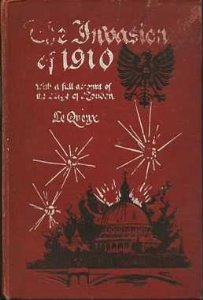 W
WThe Invasion of 1910 is a 1906 novel written mainly by William Le Queux. It is one of the most famous examples of invasion literature. It is viewed by some as an example of pre-World War I Germanophobia. It can also be viewed as prescient, as it preached the need to prepare for war with Germany.
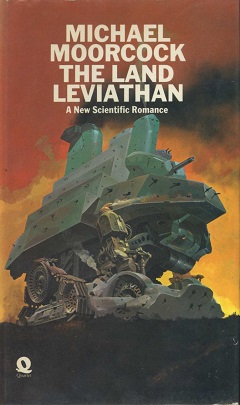 W
WThe Land Leviathan is an alternate history novel by Michael Moorcock, first published in 1974. Originally subtitled A New Scientific Romance, it has been seen as an early steampunk novel, dealing with an alternative British Imperial history dominated by airships and futuristic warfare. It is a sequel to Warlord of the Air (1971) and followed by The Steel Tsar (1981). This proto-steampunk trilogy is also published as the compilation volume A Nomad of the Time Streams.
 W
WThe Moon Maid is a fantasy novel by American writer Edgar Rice Burroughs, belonging to the Lost World subgenre. It was written in three parts, Part 1 was begun in June 1922 under the title The Moon Maid, Part 2 was begun in 1919 under the title Under the Red Flag, later retitled The Moon Men, Part 3 was titled The Red Hawk. As evident from its name, Under the Red Flag, it appears to have been originally set in contemporary Soviet Russia, with the Bolsheviks as villains ; as this was not popular with the publishers, Burroughs transferred it to a science-fictional setting, with the evil Communist-like "Kalkars" taking over the Moon and then the Earth and being finally overthrown in the third part.
 W
WNot This August, also known as Christmas Eve, is a Hugo Award shortlisted science fiction novel by C.M. Kornbluth. It was originally published in 1955 by Doubleday. It was serialized in Maclean's magazine (Canada) in May and June 1955. A revised edition with a new foreword and afterword by Frederik Pohl was published in 1981 by Tor Books, ISBN 0-523-48518-2. The title comes from author Ernest Hemingway's "Notes on the Next War".
 W
WThe Other Side of Here is an science fiction novel by American writer Murray Leinster, first published as a five-part Astounding Stories serial in 1936, under the title "The Incredible Invasion". It was first published in book form, in a "thorough revision", as one side of an Ace Double, in 1955. While no further American editions have been issued, the novel has been translated into Italian, Spanish, French and German. The novels tells the story of "an invasion from the fourth dimension", foiled by an insurrection against the invaders' home government.
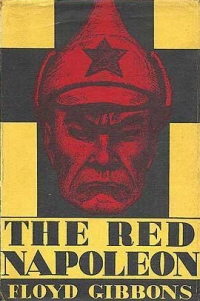 W
WThe Red Napoleon is a 1929 novel by Floyd Gibbons predicting a Soviet conquest of Europe and invasion of America. The novel contains strong racial overtones such as expressed fear of the yellow peril and of inter-racial breeding. However, the characters expressing these views are exposed in the text as being bigoted and ill-informed, as is one of the main U.S. character's views of the Soviet Union's free-love-but-with-male-accountability laws.
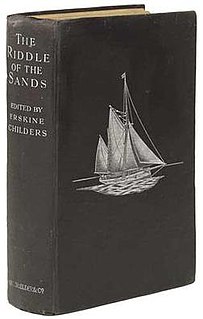 W
WThe Riddle of the Sands: A Record of Secret Service is a 1903 novel by Erskine Childers. The book, which enjoyed immense popularity in the years before World War I, is an early example of the espionage novel and was extremely influential in the genre of spy fiction. It has been made into feature-length films for both cinema and television.
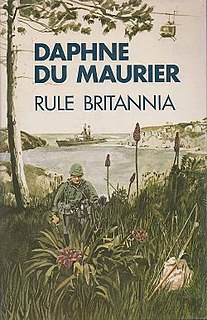 W
WRule Britannia is Daphne du Maurier's last novel, published in 1972 by Victor Gollancz. The novel is set in a fictional near future in which the UK's recent withdrawal from the EEC has brought the country to the verge of bankruptcy.
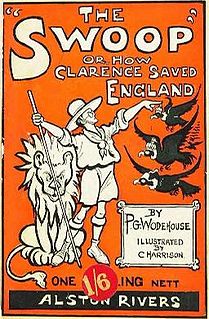 W
WThe Swoop!, or How Clarence Saved England is a short comic novel by P. G. Wodehouse, first published in the United Kingdom by Alston Rivers Ltd, London, on April 16, 1909. Its subtitle is A Tale of the Great Invasion.
 W
WTomorrow, When the War Began is the first book in the Tomorrow series by John Marsden. It was published in 1993, and is a young adult invasion novel, detailing a high-intensity invasion and occupation of Australia by a foreign power. The novel is told in first person perspective by the main character, a teenage girl named Ellie Linton, who is part of a small band of teenagers waging a guerrilla war on the enemy garrison in their fictional home town of Wirrawee.
 W
WVampire Earth is a series of science fiction/dark fantasy novels by E. E. Knight, who is also known for writing the Age of Fire series novels.
 W
WThe War in the Air: And Particularly How Mr. Bert Smallways Fared While It Lasted, a military science fiction novel by H. G. Wells, written in four months in 1907 and serialised and published in 1908 in The Pall Mall Magazine, is like many of Wells's works notable for its prophetic ideas, images, and concepts—in this case, the use of the aircraft for the purpose of warfare and the coming of World War I. The novel's hero is Bert Smallways, a "forward-thinking young man" and a "kind of bicycle engineer of the let's-'ave-a-look-at-it and enamel-chipping variety."
 W
WThe War of the Worlds is a science fiction novel by English author H. G. Wells, first serialised in 1897 by Pearson's Magazine in the UK and by Cosmopolitan magazine in the US. The novel's first appearance in hardcover was in 1898 from publisher William Heinemann of London. Written between 1895 and 1897, it is one of the earliest stories to detail a conflict between mankind and an extraterrestrial race. The novel is the first-person narrative of both an unnamed protagonist in Surrey and of his younger brother in London as southern England is invaded by Martians. The novel is one of the most commented-on works in the science fiction canon.
 W
WThe World Set Free is a novel written in 1913 and published in 1914 by H. G. Wells. The book is based on a prediction of a more destructive and uncontrollable sort of weapon than the world has yet seen. It had appeared first in serialised form with a different ending as A Prophetic Trilogy, consisting of three books: A Trap to Catch the Sun, The Last War in the World and The World Set Free.